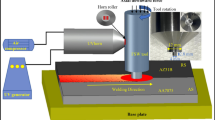Abstract
Friction stir welding has been attempted to evaluate joint strength of lap joint between aluminum sheet (AA6063) and zinc-coated steel (HIF-GA) sheet under different combination of rotational speed and traverse speed. The shear strength decreases significantly when rotational speed increases from 700 to 1,500 rpm at a traverse speed of 30 mm/min. At traverse speed of 50 mm/min, increasing rotational speed from 700 to 1,500 rpm, shear strength remains more or less the same. However, at a traverse speed of 100 mm/min, the shear strength increases significantly with increasing rotational speed from 700 to 1,500 rpm. Essentially, higher fracture load of the lap joint is obtained within a certain range of energy. The results have been correlated with the microstructural characteristics at the bond interface using energy dispersive X-ray spectroscopy, electron probe micro analyzer, and X-ray diffraction. The results show that characteristics of intermetallic compound formed at the interface derived from energy input takes predominating role towards lap joint of Al and coated steel. Furthermore, force and torque responses influenced by the processing parameters can be utilized as weld quality check.
Similar content being viewed by others
References
Barnes TA, Pashby IR (2000) Joining techniques for aluminum space frames used in automobiles. Part I—solid and liquid phase welding. J Mater Process Technol 99(1):62–71
Park SHC, Sato YS, Kokawa H (2001) Mechanical properties and microstructure in friction-stir-weld of magnesium alloy AZ61. Proceedings of the 7th International Symposium, JWS, Kobe, pp 639–644
Maruzen (1990) Welding Handbook. Edited by Japan Welding Society, p. 496.
Aritoshi M, Okita K (2002) Friction welding of dissimilar metals. J Jpn Weld Soc 71–6:432–436
Watanabe T, Yoneda A et al (1999) A study on ultrasonic welding of dissimilar metals. Q J Jpn Weld Soc 17(5):223–242, 1st report and 2nd report
Elrefaey A, Gouda M, Takahashi M, Ikeuchi K (2005) Characterization of aluminum/steel lap joint by friction stir welding. J Mater Eng Perf 14:10–17
Kimapong K, Watanabe T (2005) Effect of welding process parameters on mechanical property of FSW lap joint between aluminum alloy and steel. Mater Trans 46:2211–17
Kimapong K, Watanabe T (2005) Lap joint of A5083 aluminum alloy and SS400 steel by friction stir welding. Mater Trans 46:835–41
Elrefaey A., Takahashi A. and Ikeuchi K., (2005), Preprints of the national meeting of JWS. 73, pp.66–67
Chen YC, Komazaki T, Kim YG, Tsumura T, Nakata K (2007) Int. Weld Join Conf, Seoul, pp 435–36
Zimmer S, Langlois L, Laye J, Bigot R (2010) Experimental investigation of the influence of the FSW plunge processing parameters on the maximum generated force and torque. Int J Adv Manuf Technol 47:201–215
Ahmed E, Takahashi M, Ikeuchi K (2005) Friction-stir-welded lap joint of aluminum to zinc-coated steel. Q J Jpn Weld Soc 23(2):186–193
Chen YC, Nakata K (2008) Effect of the surface state of steel on the microstructure and mechanical properties of dissimilar metal lap joints of aluminum and steel by friction stir welding. Metall Mater Trans A 39A:1985–1992
ASM (1973) Metals handbook, vol. 8 Metallography, structures and phase diagram, Metals Park: ASM International
Pretorius R, Vredenberg AM, Saris FW (1991) Prediction of phase formation sequence and phase stability in binary metal–aluminum thin–film systems using the effective heat of formation rule. J Appl Phys 70:3636
Pretorius R, de Reus R, Vredenberg AM and Saris FW (1990), Mater. Lett. 9, pp. 494.
Kobayashi K., Nishimoto K., and Ikeuchi K., Zairyo Setsugo Kogaku No Kiso, (2002), Introduction to joining engineering of materials, Sampo, pp.182-188
Khandkar MZH, Khan JA, Reynolds AP (2003) Prediction of temperature distribution and thermal history during friction stir welding: input torque based model. Sci Technol Weld Join 8:165–74
Santella M, Grant G, Arbegast W, Plunge testing to evaluate tool materials for friction stir welding of 6061+20wt% Al2O3 composite, (2003), Proceedings of the 4th International Symposium on Friction Stir Welding, Part City, USA
Author information
Authors and Affiliations
Corresponding author
Rights and permissions
About this article
Cite this article
Das, H., Basak, S., Das, G. et al. Influence of energy induced from processing parameters on the mechanical properties of friction stir welded lap joint of aluminum to coated steel sheet. Int J Adv Manuf Technol 64, 1653–1661 (2013). https://doi.org/10.1007/s00170-012-4130-3
Received:
Accepted:
Published:
Issue Date:
DOI: https://doi.org/10.1007/s00170-012-4130-3




